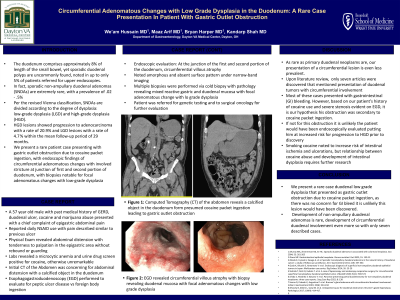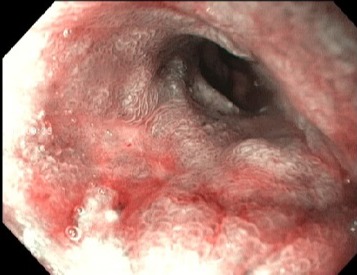Monday Poster Session
Category: Small Intestine
P2668 - Circumferential Adenomatous Changes With Low-Grade Dysplasia in the Duodenum: A Rare Case Presentation in Patient With Gastric Outlet Obstruction
Monday, October 23, 2023
10:30 AM - 4:15 PM PT
Location: Exhibit Hall

Has Audio
- WH
We'am Hussain, MD
Wright State University
Dayton, OH
Presenting Author(s)
We'am Hussain, MD1, Maaz Arif, MD1, Jaser Siddiqui, BS2, Bryan Harper, MD1, Kandarp Shah, MD3
1Wright State University, Dayton, OH; 2Loyola University, Lincolnwood, IL; 3Dayton Veteran Affairs Medical Center, Dayton, OH
Introduction: Sporadic non-ampullary duodenal adenomas (SNDAs) are rare, with a prevalence of 0.02 % to 0.5%, usually found incidentally during endoscopy. These adenomas are pre-cancerous and the risk of developing adenocarcinoma from low-grade dysplasia is 4.7% and from high-grade dysplasia is 20.9%.
Case Description/Methods: A 57-year-old male with history of GERD, duodenal ulcer, and cocaine use presented with epigastric abdominal pain. He reported NSAID use and affirmed his pain resembled his prior duodenal ulcer pain. Exam revealed abdominal distention with tenderness to palpation in the epigastric area without rebound or guarding. Initial computed tomography of the abdomen was concerning for gastric distention with a calcified object in duodenum. Labs revealed microcytic anemia and positive urine drug screen. Patient underwent esophagogastroduodenoscopy or evaluation of peptic ulcer disease vs foreign body ingestion. Upon endoscopic evaluation, at the junction of the first and second portion of the duodenum, proximal to the Ampulla of Vater, he had circumferential villous atrophy, noted as amorphous and absent surface pattern under narrow-band imaging. This area extended 6 cm with duodenal stricture. Multiple biopsies were performed via cold biopsy with pathology revealing mixed reactive gastric and duodenal mucosa with focal adenomatous change with low-grade dysplasia.
Discussion: As rare as primary duodenal neoplasms are, a circumferential presentation is even less prevalent. Upon literature review, only seven articles mentioned presentation of duodenal tumors with circumferential involvement. Two of these articles were evaluating surgical techniques for removal, two were Brunner’s gland adenomas two were embryonic adenomas, and only one was an adenocarcinoma presenting without stenosis. Most of these cases presented with GI bleeding. In our case this patient was found to have a longer segment of duodenum involvement than cases sited previously and presented for concern of gastric outlet obstruction rather than GI bleeding. Given prior cocaine use and the severe stenosis on EGD, his obstruction was likely due to cocaine packet ingestion. If not for this obstruction, it is unlikely the patient would have been endoscopically evaluated putting him at increased risk for progression to HGD.
This was a rare patient that presented as gastric outlet obstruction due to cocaine packet ingestion, whose development of non-ampullary duodenal adenomas may not have been discovered.

Disclosures:
We'am Hussain, MD1, Maaz Arif, MD1, Jaser Siddiqui, BS2, Bryan Harper, MD1, Kandarp Shah, MD3. P2668 - Circumferential Adenomatous Changes With Low-Grade Dysplasia in the Duodenum: A Rare Case Presentation in Patient With Gastric Outlet Obstruction, ACG 2023 Annual Scientific Meeting Abstracts. Vancouver, BC, Canada: American College of Gastroenterology.
1Wright State University, Dayton, OH; 2Loyola University, Lincolnwood, IL; 3Dayton Veteran Affairs Medical Center, Dayton, OH
Introduction: Sporadic non-ampullary duodenal adenomas (SNDAs) are rare, with a prevalence of 0.02 % to 0.5%, usually found incidentally during endoscopy. These adenomas are pre-cancerous and the risk of developing adenocarcinoma from low-grade dysplasia is 4.7% and from high-grade dysplasia is 20.9%.
Case Description/Methods: A 57-year-old male with history of GERD, duodenal ulcer, and cocaine use presented with epigastric abdominal pain. He reported NSAID use and affirmed his pain resembled his prior duodenal ulcer pain. Exam revealed abdominal distention with tenderness to palpation in the epigastric area without rebound or guarding. Initial computed tomography of the abdomen was concerning for gastric distention with a calcified object in duodenum. Labs revealed microcytic anemia and positive urine drug screen. Patient underwent esophagogastroduodenoscopy or evaluation of peptic ulcer disease vs foreign body ingestion. Upon endoscopic evaluation, at the junction of the first and second portion of the duodenum, proximal to the Ampulla of Vater, he had circumferential villous atrophy, noted as amorphous and absent surface pattern under narrow-band imaging. This area extended 6 cm with duodenal stricture. Multiple biopsies were performed via cold biopsy with pathology revealing mixed reactive gastric and duodenal mucosa with focal adenomatous change with low-grade dysplasia.
Discussion: As rare as primary duodenal neoplasms are, a circumferential presentation is even less prevalent. Upon literature review, only seven articles mentioned presentation of duodenal tumors with circumferential involvement. Two of these articles were evaluating surgical techniques for removal, two were Brunner’s gland adenomas two were embryonic adenomas, and only one was an adenocarcinoma presenting without stenosis. Most of these cases presented with GI bleeding. In our case this patient was found to have a longer segment of duodenum involvement than cases sited previously and presented for concern of gastric outlet obstruction rather than GI bleeding. Given prior cocaine use and the severe stenosis on EGD, his obstruction was likely due to cocaine packet ingestion. If not for this obstruction, it is unlikely the patient would have been endoscopically evaluated putting him at increased risk for progression to HGD.
This was a rare patient that presented as gastric outlet obstruction due to cocaine packet ingestion, whose development of non-ampullary duodenal adenomas may not have been discovered.

Figure: Endoscopy showing circumferential villous atrophy appearance of the second portion of the duodenum.
Disclosures:
We'am Hussain indicated no relevant financial relationships.
Maaz Arif indicated no relevant financial relationships.
Jaser Siddiqui indicated no relevant financial relationships.
Bryan Harper indicated no relevant financial relationships.
Kandarp Shah indicated no relevant financial relationships.
We'am Hussain, MD1, Maaz Arif, MD1, Jaser Siddiqui, BS2, Bryan Harper, MD1, Kandarp Shah, MD3. P2668 - Circumferential Adenomatous Changes With Low-Grade Dysplasia in the Duodenum: A Rare Case Presentation in Patient With Gastric Outlet Obstruction, ACG 2023 Annual Scientific Meeting Abstracts. Vancouver, BC, Canada: American College of Gastroenterology.
